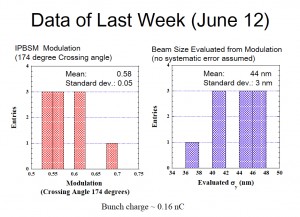Last month, LC NewsLine reported the achievement of the world’s smallest beam size of 55 nanometres at the ATF2 facility at KEK. At two international conferences held in June and July, the next record of 44 nanometres was reported by Kiyoshi Kubo and Shigeru Kuroda.
The beam line at ATF2 is designed as a prototype of the final focus system of the ILC, with basically the same optics, similar beam energy spread, natural chromaticity and tolerances of magnetic field errors.
For linear colliders, realising an extremely small and stable beam is essential. At the ILC, the design vertical beam size and required position stability at the interaction point is at the nanometer level. The target beam size at ATF is 37 nanometres. Because of the difference in the beam energy, 37 nanometres at ATF will correspond to smaller than 5 nanometres at the ILC, the specification for the ILC design.. The result presented at ICHEP and IPAC was just one step away from the target size.
Kubo said the most important factor of the improvement was the stabilisation of the beam orbit by improving the feedback system. “We installed a new magnet for better feedback and improved the software, which worked to stabilise the beam. The beam was stable for 30 to 60 minutes without tuning in most cases.”
“Also, we removed as much possible strong wakefield sources on every weekend when we stop the operation,” said Kuroda. “To put it in a nutshell, the further stabilisation of the beam and reduction of wakefield,” said Kuroda about the contributing factors.
The beam size is still slightly larger than the target size of 37 nanometres. ATF is now under summer shut-down, and the scientists are planning to work on the remaining issues in the autumn this year.


Recent Comments